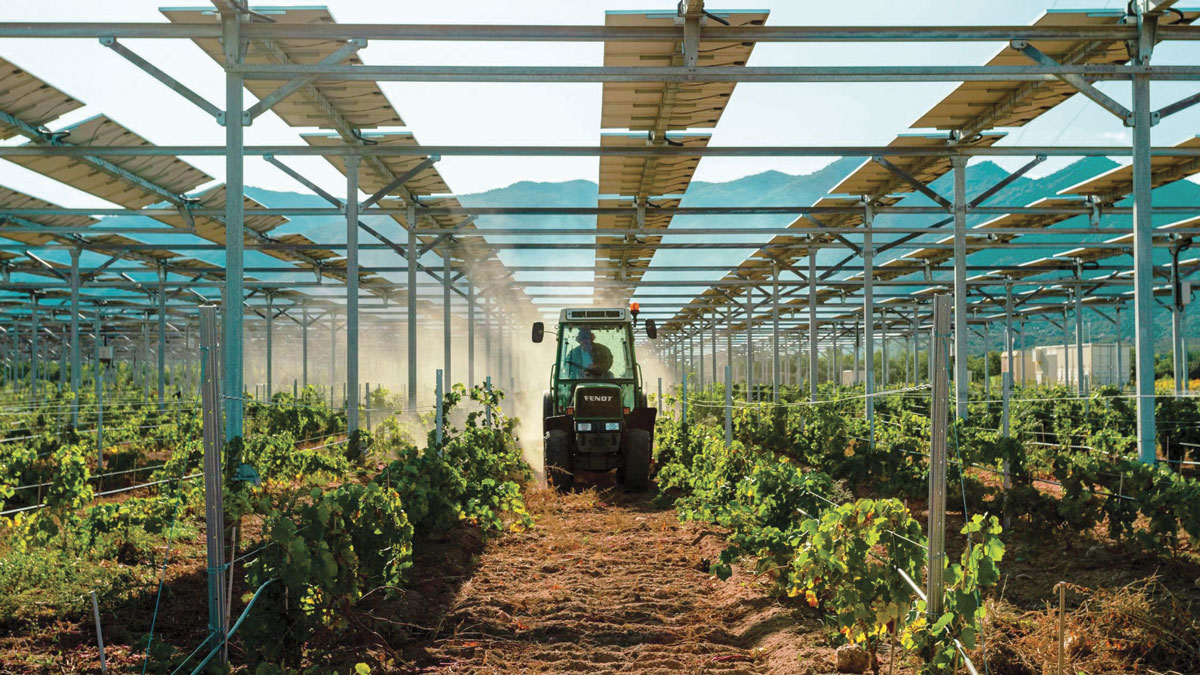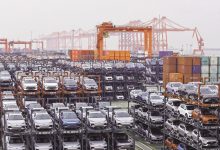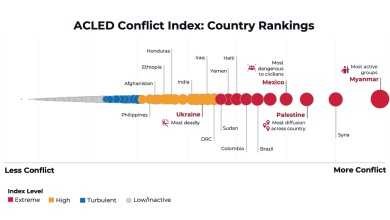Agrivoltaism: A Win-win System?
Is agrivoltaism a win-win system? Installing solar panels on top of agricultural crops through the agrivoltaic system provides many benefits, but it also gives birth to many controversies.
Community policies provide for a clear and real coordination of energy crops and those intended for food, so that each country can establish the destination of the adequate land use, to provide a sustainable gain for both parts – food and energy.
Renewable energy sources are a priority for the European Union, especially in the context of climate challenges. Energy production has never been so important for the strategic autonomy of Europe, believes Thierry Breton, Commissioner for the Internal Market of the European Union.
Agrivoltaism allows to keep agricultural land and use the land areas for the development of renewable energy. The importance of photovoltaic panels in the carbon neutrality policy by 2050 should not be neglected either, reconciling the climate and industrial ambitions of the European Union.
Solar energy on agricultural land at European level
Currently, solar power is a very important source of renewable and sustainable energy, capitalized through an ever-evolving technology range. The cell used to make modules five years ago, for example, is no longer used today. Therefore, constant innovation is needed.
At the CEA-Liten Institute (The French Alternative Energies and Atomic Energy Commission), the first European research centre fully dedicated to energy transition, a contribution is made to the development of new-generation cells with a much higher efficiency than those available on the current market. The mass market is currently offering efficiency levels between 22 and 23% for the conversion of sunlight into electricity. Work is being done on a generation that could reach an efficiency of 25%, while preparing the next generation that is expected to exceed efficiencies of 30%. This is known as a tandem cell approach, which involves combining two types of material, one based on silicon while the other is organic. European academics are also working a new PV module project suitable for desert environments, as well as other research and innovation projects within the scope of the Horizon Europe framework program.
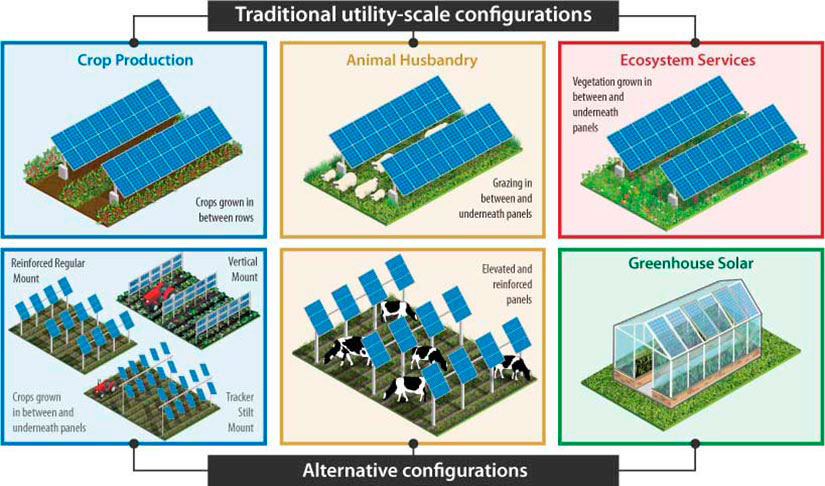
PV cell improvement
Because of rising concern about the impact of fossil fuel-based energy on global warming and climate change, photovoltaic cell technology has advanced significantly in recent years as a sustainable source of energy.
To date, photovoltaic cells have been split into four generations, with the first two generations accounting for most of the current market.
First generation of thin-film technologies is based on monocrystalline or polycrystalline silicon and gallium arsenide cells and includes well-known medium- or low-cost technologies with moderate yields, whereas second generation includes devices with lower efficiency and manufacturing costs.
Third generation is based on novel materials and has a wide range of design options, as well as expensive but highly efficient cells. However, fourth generation, also known as “inorganics-in-organics,” combines the low cost and flexibility of polymer thin films with the durability of innovative inorganic nanostructures (metal nanoparticles or metal oxides) in organic-based nanomaterials (Materials for Photovoltaics: Overview, Generations, Recent Advancements and Future Prospects by Muhammad Aamir Iqbal, Maria Malik, Wajeehah Shahid, Syed Zaheer Ud Din, Nadia Anwar, Mujtaba Ikram and Faryal Idrees/January 20th, 2022).
Third-generation PV cells
These organic semiconductors or dye-sensitized solar cells could be interesting in that they could contribute to the production of electricity outside the spectral regions required for plant photosynthesis (especially the red and blue spectral bands of the visible spectrum). They could be considered photo-selective covers.
These cells could be particularly suitable for existing infrastructures such as greenhouses, where they could be, for example, attached to the wall. Despite the features that seem promising in terms of flexibility, brightness, colour diversity, degree of transparency and environmental costs, these technologies are not yet stable or efficient enough to convert solar energy into electricity.
Concentrator cells
The technology of luminescent solar concentrators (such as those developed by the Swiss company Insolight) aims to focus a beam of light on a given point of a photovoltaic cell, thanks to optical lenses, to maximize its intensity. The interest of these concentrator cells would also lie in their ability to separate direct light from diffuse light (the latter being able to be transmitted to crops).
The cells would be able to track the sun by moving horizontally a few millimetres per day to keep the cells aligned with the component of the light beam. These technologies are still in the development stage, being relatively expensive and relatively difficult to implement, given the precision required in moving the cells to ensure alignment with the light beam.
Insolight’s first agrivoltaic pilot installation in France is completed. The pilot uses insolagrin dynamic agrivoltaic solution over strawberries. The project was created in partnership with Amarenco and Invenio. Energesia is the photovoltaic installer for the project.
Perovskites could take solar cells to new heights
Researchers at the U.S. Department of Energy’s (DOE’s) National Renewable Energy Laboratory (NREL) made a technological breakthrough and constructed a perovskite solar cell with the dual benefits of being both highly efficient and highly stable.
The work was done in collaboration with scientists from the University of Toledo, the University of Colorado-Boulder, and the University of California-San Diego.
A unique architectural structure enabled the researchers to record a certified stabilized efficiency of 24% under 1-sun illumination, making it the highest reported of its kind. The highly efficient cell also retained 87% of its original efficiency after 2,400 hours of operation at 55 degrees Celsius.
Perovskite, which refers to a crystalline structure, has emerged in the last decade as an impressive means to efficiently capture sunlight and convert it to electricity. Research into perovskite solar cells has been focused to a large degree on how to increase their stability.
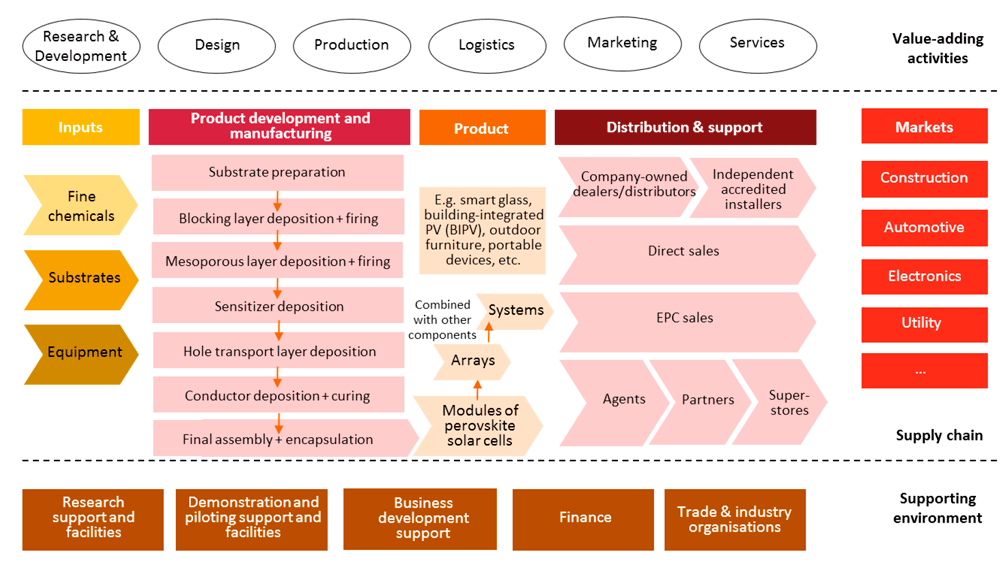
Instruments and technologies under development
Photovoltaic panels technologies are constantly evolving. These technologies are obviously not specific to agrivoltaics as such – some research focuses on improving the efficiency of PV panels – but it is always interesting to follow the trends.
Some operators have started to implement three-dimensional photovoltaic tables that can be moved and integrate photovoltaic modules directly into their structure.
Mobile solar units are also starting to appear. These units can be designed of as pre-assembled solar panels in a container – the container consists of 200 pre-assembled and pre-wired PV panels that can be quickly installed and moved. Although these units were initially designed for disaster areas, they could be used in complex cropping or lever systems.
Semi-transparent tables
Unlike conventional opaque tables, semi-transparent tables contain conventional PV cells, but also transparent spaces on the table to let more light through. These tables, by construction, generate less power since there are fewer photovoltaic cells per square meter. However, the price of these tables is relatively higher than for conventional tables, so there is a compromise between agricultural production and energy production by the panels.
Agricultural robots under PV panels?
Since the environments under the panels are very structured and controlled, could we envisage having agricultural robots working under the panels (for example, weeding robots)? The fact that an infrastructure already exists could even be an asset for moving robots (on rails). Fences around PV installations could be an opportunity to use robotic machines in a safe way, and not be constrained by the Machinery Directive (which requires an operator to be present on site to ensure that the robot does nothing).
If we also consider the issue of energy autonomy of robots, the fact that these robotic units operate under photovoltaic panels, i.e., with a potential source of renewable energy at their disposal, could make it possible to move towards a reduction of dependence on fuels. But this is a matter of the future.
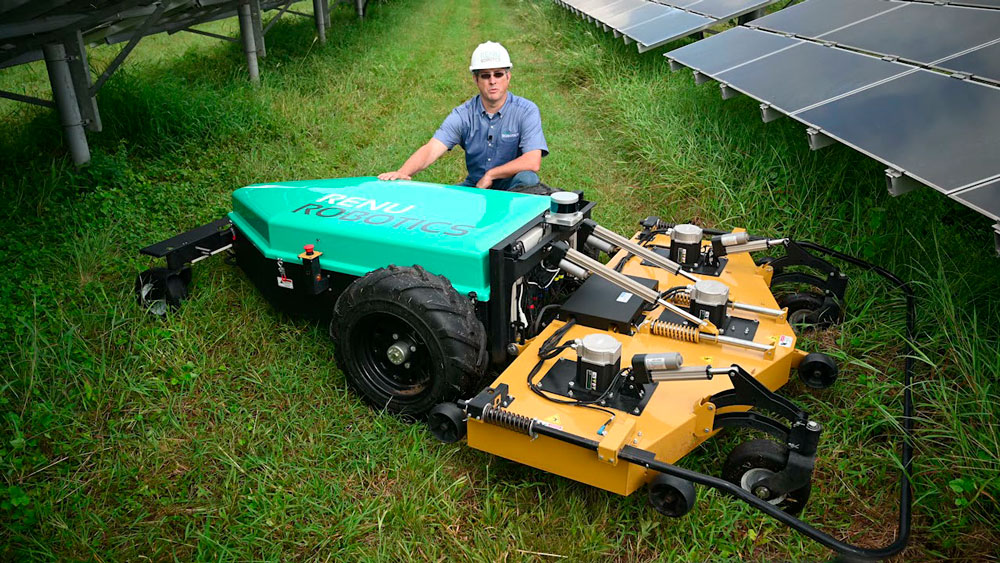
Risks and constraints of agrivoltaics
Agrivoltaism is still in the experimental stage. Therefore, real performance, especially in the long run, cannot be fully guaranteed, even if the initial results are encouraging.
Therefore, the agrivoltaism practice is unavoidably debated in the agricultural sector. Some fear in particular that this system will be more profitable for solar energy production and less for agricultural crops. Installing an agrivoltaic plant is indeed quite complex and must take into account many aspects to be effective, including the layout of the solar panels, the type of terrain or the reliability of the safety devices. Lastly, the visual effect of PV panels in agricultural crops is not to everyone’s taste and, therefore, can represent an additional constraint.
Currently, very few photovoltaic parks are truly adapted to agrivoltaism. Given the few data currently available, confidentiality issues are significant. Those who have some data are not very prone to share it, firstly because they don’t necessarily know what they offer (they don’t have long-term data) and secondly because they know even less what they could recover (if other operators would provide their data) and how the information will be disseminated. Some countries, such as Israel, have opened tenders with categories dedicated to agrivoltaism for many small-scale projects; a way in which they can multiply projects across territories and thus collect a lot of data.
There is a general agreement for the recovery of knowledge, but when it comes to investing money to generate such knowledge, it’s a different issue. Some manufacturers would agree to perform a relatively simple monitoring, but it will be difficult for them to integrate these costs in their business plans. With the committees for coordinating and monitoring the new agrivoltaic projects – committees required by chambers of agriculture or by operators – it is just as long to wait before we can have really exploitable results.
Given the diversity of agricultural projects, it is relatively difficult to generalize the results. The question is whether, given the existing multitude of farms and cropping patterns, the stakeholders will have enough data to make serious statistical analyses after several years. Soil and climate conditions, crop rotation and cropping patterns are all variable parameters that are not necessarily standardized. Therefore, it is difficult to be overly confident in terms of panels’ impact on biomass production, the selection of the most appropriate species for the photovoltaic installations, the impact of the plants on the welfare of animals or the most optimized technological devices for a given production (width and inclination of panels, height of structures etc.). For now, perhaps we should rather accept that we don’t know everything.
Benefits of agrivoltaism
Installing solar panels on top of agricultural crops through the agrivoltaic model provides many benefits. The first is that it allows agriculture to adapt to climate change. It is indeed a tool for protecting agricultural crops against extreme temperatures (frost and heat waves) or the elements, such as hail, that can have disastrous consequences on production. This therefore allows improving the agricultural yields, while using the area available to the benefit of renewable energy by producing photovoltaic power. Moreover, agrivoltaism allows water saving through the principle of evapotranspiration, which was accentuated in the agricultural crops such as grapevine.
The installation of fixed structures above the vineyards or fruit trees must also protect crops from calamities (hail) and certain effects of global warming: drought, heat wave.
For a decade, researchers from INRAE (French National Institute for Agricultural Research) have been evaluating the condition of the soils, the plants, and the quality of production from the plots cultivated under the panels.
By masking part of the solar radiation, the aerial solar plant ‘improves’ the microclimate that reigns over the crops. This, in periods of high heat, favours the growth of plants and reduces their water requirement (irrigation), confirm the engineers from INRAE.
Mandatory pilotage
The agrivoltaic system is all the more efficient when it is controllable. Mounted on structures several meters high, the panels are fixed on motorized ball joints. This usually allows them to follow the path of the sun. By positioning them vertically, the agrivoltaic panels also deploy the anti-hail nets (attached to their masts). Horizontally, they block strong winds.
For example, a 540 sqm plot of the experimental vineyard was covered with a panel roof. Despite the very warm weather (temporary temperatures over 50°C were recorded), the grapes continued to grow. Equally important for winegrowers, the juice extracted from the grapes is of good quality. “Despite the severity of the climate, we noticed an increase in anthocyanin levels and acidity,” notes the head of Sun’Agri’s agriculture division.
How does an agrivoltaic plant work
Agrivoltaism consists of positioning solar panels on top of agricultural crops to combine crop optimization with photovoltaic electricity production.
In the case of the Sun’Agri’s offer, the panels are automatically oriented in real time according to the needs of the plants through an intelligent algorithm.
Photovoltaic panels lose about 2% of their power when they are installed and then 0.5% of their power every year. Photovoltaic panels are generally guaranteed for 20 years (some panels are guaranteed longer than that).
It is important to understand that a certain efficiency of panels – usually at least 80% – is guaranteed for these 20 years. The panel can continue to work after this time, but at a lower efficiency.
The current energy yield of photovoltaic cells is around 20%, i.e., the cells are able to convert 20% of the solar energy they receive into electrical energy. This efficiency is steadily increasing.
Some conventional ground-mounted solar parks are dismantled and reassembled with new, more efficient panels. It’s about 1st generation photovoltaic cells (based on crystalline silicon), 2nd generation photovoltaic cells (based on amorphous silicon in thin layers) and 3rd generation photovoltaic cells (based on organic compounds).
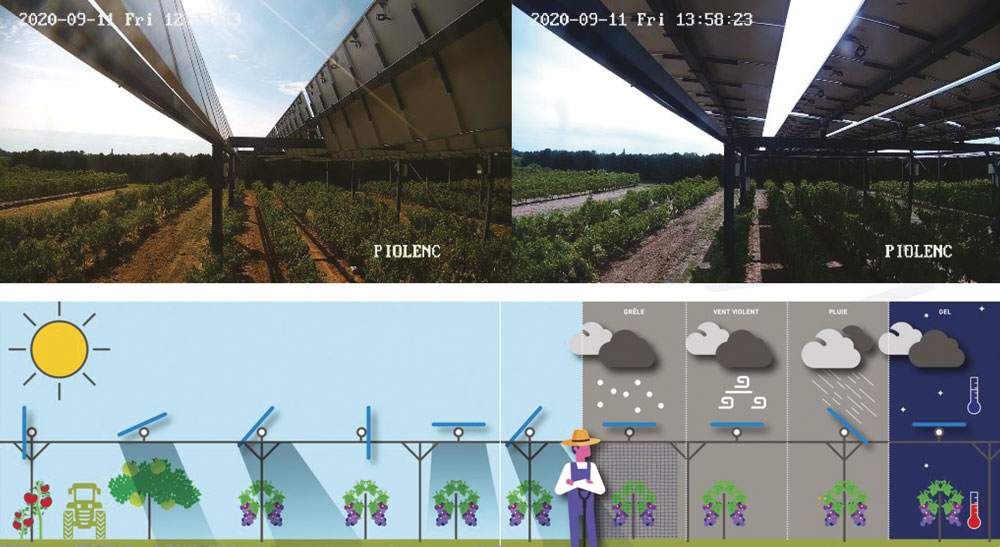
Agrivoltaism is not suitable for all crops
In some cases, decreasing plant exposure to sunlight and reducing crop contact with rainwater could lead to negative results. Depending on climate and season, these effects can be beneficial or negative, depending on the crop type.
Where’s why the success of the technique is based on a smart balance between sunlight, watering, shading and protection from the cold.
A photovoltaic project on a farmland (whether it is considered agrivoltaism or not) includes at least:
- Agricultural crops under panels (in crop production) and usually grassland (in animal production)
- Photovoltaic tables, each containing photovoltaic cells capable of producing electricity
- A more or less complex infrastructure to hold the photovoltaic tables (steel bars, piles, ground anchors etc.)
- An inverter to transform the direct electric current generated by the photovoltaic cells into alternating current so that this current can be integrated into the grid and be reused by other people. The inverter can work without a power grid and can power for example a battery on site. Usually, photovoltaic tables are connected to the electricity grid because the electricity is sold back to the grid.
- A set of technical and logistical infrastructures (fence to protect the photovoltaic plant, access roads).
Agrivoltaism and photovoltaic greenhouses: what is the difference?
Agrivoltaism differs from photovoltaic greenhouses by placing agriculture before electricity production. The layout of the solar panels is in such a way as not to damage the quality of the land and to protect the crops as best as possible from climate change for better agricultural yields.
Agrivoltaism is a win-win system. The process makes it possible to reconcile the preservation of agricultural land with the use of land surfaces for the development of renewable energy. The technique also allows an increased efficiency of solar panels, while increasing agricultural production. The combined yield of the two activities (agricultural crop and energy production) is higher than the sum of the two taken individually.
Due to the reduction of evapotranspiration, in the case of protected vines, the need for water is reduced by 12% to 34%. In addition, the aromatic content of the grapes is improved: +13% anthocyanins (red pigments) and 9% to 14% more acidity. Rural areas depend on agriculture and need access to electricity for a sustainable existence. Since agriculture consumes a large amount of electricity for irrigation, tillage, greenhouses, heating and cooling of buildings, farms, animals etc., the bills can drain the budget.
According to IEA estimates, energy use in agriculture includes both direct and indirect use: diesel, electricity, natural gas, renewable fuels for farm operations, raw materials. In general, the distribution of energy sources in crops and livestock requires nearly 250 Btu and 150 Btu of distillate fuels, respectively.
There is no lack of neologisms to designate this recent technique: some speak of agro-photovoltaic, agrosolar, others of photovoltaicization of agricultural land, solar sharing, agrinergy, or simply agrivoltaism.
The technique is suitable for certain fruit and vegetable crops, for vines – especially for the crops most affected by climate change. A violent storm, hail or heat wave can destroy months of work in just a few minutes and ruin a farmer.
Agrivoltaism, a universal panacea?
It’s not that simple, experts say, because agrivoltaism only makes sense if it first addresses the needs of farmers, if it promotes the climate resilience of their crops. If the panels are incorrectly installed and poorly controlled, the system can prove disastrous, they say, criticizing developers who sterilize agricultural land with ground-based photovoltaic farms.
European photovoltaic industry
In its latest report, Ember highlights the new records set in Europe for solar generation over the summer months. 18 of the 27 EU Member States set new solar generation records, equating to 99.4 TWh of solar electricity – a 28% increase from summer 2021.
Russia’s invasion of Ukraine has sent shockwaves through Europe, with rising fears about energy security and citizens facing astronomical energy prices. As we move towards the winter, Europeans are fearing energy bills they risk being unable to pay. In these times of crisis, solar can provide the solution by offering affordable, reliable, and clean energy.
The Ember report notes that solar records were broken in 18 EU countries with Poland seeing solar generation increased 26 times, followed by 5-fold increases in Finland and Hungary. The overall increase in generation saved 20bcm of fossil gas imports avoiding costs of EUR 29 billion.
This trend will continue, as new renewable energy targets are being discussed for 2030, and the EU pursues carbon neutrality by 2050.
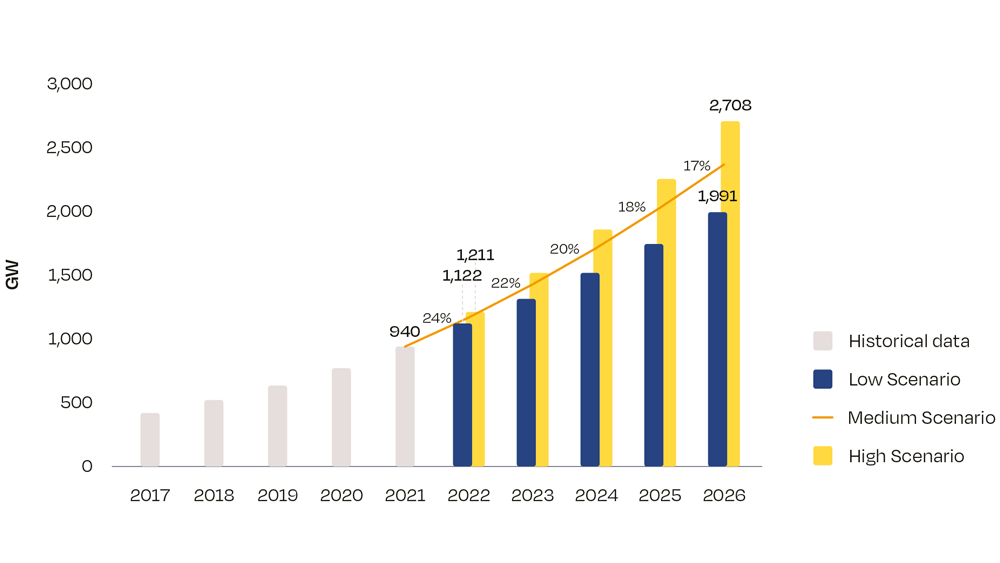
2021, the best year for the European PV market
In 2021, the European Union installed 25.9 GW of new PV capacity, representing an annual increase of 34%. In 2025, the European solar market is expected to almost double compared to today – 49.7 GW versus 25.9 GW.
SolarPower Europe forecasts average growth rates of 18-20%, an increase of around 162.7 GW to reach 327.6 GW by the end of 2025. This means that the EU’s solar generation fleet will double in four years from the 164.9 GW in operation today.
Agrivoltaic power plant projects involve multiple players and economic models
- The farmer who will place the PV installation on top of his production
- The agrivoltaic operator developing the power plant project
- The owner of the agricultural land on which the plant will be built
- The service company – especially in the case of dynamically controlled photovoltaic panels – that developed the technologies and algorithms to control the panels
Economic models are complicated by the fact that the roles of these actors are sometimes a bit mixed. The landowner and the farmer can be the same person, or they can be two different people (some PV operators still do not distinguish between a landowner and a farmer). The PV operator may be the landowner (although this is less common). And the service company is not yet present in many different business models.
With this set of actors, the business models of agrivoltaic projects are quite varied:
- The PV operator pays a rent to the farmer to rent the farmland on which the operator installs the PV plant.
- The farmer is self-financing the project. If the farmer is not able to provide capital from the bank, he can be a minority or majority shareholder in a project (with participatory financing from citizens or the territory). PV projects can be launched by a group of farmers.
- The owner establishes a lease agreement with the PV operator.
- The PV operator finances the PV infrastructure for the farmer (e.g., a greenhouse on which photovoltaic panels will be placed). It is therefore the PV operator who invests and operates the PV panels. This format costs the farmer nothing, but the PV operator owns the whole thing. In some cases, the operator may also own the plant material.
- The service company sells to the farmer a dynamic control service and a patented technology to the PV operator (the service company contracts a pre-calculated cleaning rate of the photovoltaic tables and guarantees the PV operator that the panels will be cleaned all the time).
Paying rent: A risk for the agricultural sector?
The most worrying issue is still farmer remuneration. The photovoltaic world and the agricultural world don’t necessarily get along. A farmer’s average gross margin per hectare is close to EUR 500 (probably excluding peaks for rapeseed and wheat). By sometimes offering farmers rents of several thousand euros per hectare for the installation of agricultural projects, PV operators seem unaware of the problems of the agricultural world. Several players are also against such schemes and are not in favour of a model with a rent payable to the farmer. For some, paying rent would be tantamount to questioning the sustainability of the agricultural system.
The introduction of a rent could lead to the risk of abandonment of agriculture (degradation of the agricultural nature of the land in planning regulations, marked degradation of agricultural production) and destabilization of agricultural land, with land prices likely to rise. In addition to land speculation linked to electricity feed-in tariffs and the margins of the photovoltaic sector, some operators tend to adopt aggressive land strategies with the desire to retain and secure land (to avoid land theft by competitors). Some operators will even go so far as to offer very high rents, simply to push farmers into signing contracts, which operators will then sell to other developers looking for land. Developers will sometimes be prepared to pay very high prices for these land insurance contracts. Other business providers will secure land where it is not always technically feasible, and farmers can be stuck with promises of rent that cannot be overpriced. Other operators, on the contrary, will sign these leases with conditions precedent (e.g., only if the building permit is signed). Others will wait for good economic conditions to develop before committing themselves.
In general, the impact of PV projects on the economy of farms as a whole is relatively unmentioned and perhaps not sufficiently addressed. The issues to be considered are extremely numerous:
- Possible loss of CAP (Common Agricultural Policy) support
- Potential rents
- Impact on agricultural production in terms of quantity and quality
- Organizational, operational, and logistical changes in agricultural routes
- Work rates may be increased if plant designs are not sufficiently well thought out, the potential need for equipment renewal
- Salary issues (with potential additional salary requirements as a result of installing a PV project)
- Energy issues
Romania introduces law to promote solar development on agricultural land
Romania should implement new regulations, in particular adjusting land rights to facilitate the development of renewable energy projects on agricultural land. The new provisions will come into force by 2026 and will allow the construction of photovoltaic plants, wind turbines, biomass plants, biogas plants, storage projects and transformer stations directly on the land, falling under the previously prohibited classes of agricultural land.
The Romanian Parliament recently adopted an amendment to the Land Law 18/1991 that could remove regulatory barriers to the development of renewable energy projects on agricultural land.
Law amending and supplementing the Land Law, promulgated by the President of Romania
“By exception, the following investment objectives specific to the production of electricity from renewable sources may be located on agricultural land of quality class III, IV and V, with the category of arable use, pasture, vineyards and orchards, as well as on those developed with land improvement works, located outside the urban area, on the basis of the building permit and the approval of the definitive or temporary removal from agricultural use: solar, wind, biomass, bioliquids and biogas energy production capacities, electricity storage units, transformer stations or other similar systems that may be located on agricultural land located in outside the urban area, in surface of a maximum of 50 ha. These investments can also be applied, by exception, on agricultural land of quality class I and II,” according to the law promulgated in July this year by the Head of State.
The new provisions authorize the development of photovoltaic, wind, biomass, bioliquids, biogas, storage, and transformer station projects directly on land located outside urban areas and falling into fertility classes III, IV and V. Until now, development was prohibited on these sites. The new rules also state that such land can be used for dual-use projects, including energy production and agricultural activities.
Construction work has long been permitted only on sites registered as intramural construction land.
“Although there are ad hoc exemptions on this measure, none of them relate to renewable energy projects,” said Mihaela Nyerges, Partner at Vlasceanu, Nyerges & Partners. “The new law mainly paves the way for agrivoltaic projects and solves some of the permitting problems faced by developers.” For example, the approval of a zonal urban plan (PUZ) to change intramural land allocations will no longer be required. “Instead, a special procedure should be carried out to change the land category from agricultural land to built-up land,” she said. “However, this procedure is significantly quicker than the PUZ procedure, as the authorities will have to give their opinion within 45 days from the date of application, otherwise the application will be considered tacitly approved.”
The new rules also set lower licensing fees for PV projects for dual system applications.
“If a dual system is implemented, the change of land category from agricultural to buildable will no longer apply to all the land allocated to the renewable energy project, but only to the specific part of the land that can no longer be used for agricultural purposes,” said Mihaela Nyerges. “In the case of photovoltaic projects, this is very important because a higher pole mount allows for agricultural activities/animal grazing under the panels and therefore allows for a much smaller area of land to be affected,” the specialist concluded.
The new law only applies to sites of up to 50 hectares. This restriction can have a significant impact on the profitability of PV projects, insofar as the high cost of connection is only commercially acceptable if the project capacity is large.
The new law will only apply until December 31, 2026
The deadline is 2026, as the aim is to boost investment in renewable energy during the current EU budget (2021-27) to increase the absorption rate of available EU funds. Following the national recovery and resilience plan launched a few months ago, the sector is looking forward to the Modernization Fund which should, after many delays, be accessible this autumn.
Agrivoltaism, a divisive system
This solution is a divisive one, because the fear of seeing energy production take over the reins of agriculture is great. The concern is also reflected in the additional equipment used with these photovoltaic panels, which are often accompanied by a high-voltage line and a substation as a source.
Labelling of plots equipped with agrivoltaic system
As a public institution, INRAE (National Research Institute for Agriculture, Food, and the Environment) provides scientific monitoring of the development of control plots (without solar installation) and plots equipped with agrivoltaic systems. The objective of this comparison is to label the device as soon as the environmental gain on equipped plots is well proven.
The aim is twofold: on the one hand to avoid abuses, as some farmers might be tempted to cover their fields with solar panels to increase their income at the expense of agricultural production. And on the other hand, the device must be exported to the international market. Major agricultural producers such as Australia, California or sub-Saharan Africa will certainly benefit from this innovative technology.
Influencing factors of photovoltaic plants for perennial crops
In terms of output, the effects of PV plants appear to be generally neutral to negative. In any case, plants would not need 100% light to grow best. The growth of some plants is rather stimulated with medium levels of shading. However, when high levels of light obscuration are reached, a significant loss of yield can be expected.
In any case, the relationship between light radiation decreases and yield is not linear. However, some recent projects have shown an increase in productivity under panels with very fine light control, by limiting photo-inhibition periods during intense sunlight so that plants do not stop growing in the middle of the day. The long-term effects of this have not yet been studied but should not be overlooked. By limiting photosynthesis during the season in a perennial, there is a risk of affecting the development of the following year (reserves are affected, as is flower induction). The light saturation point hypothesis is developed at the leaf level. At the scale of the plant, the question is perhaps different in that light reaching one leaf will be transmitted and diffused to the other leaves of the plant. Energy flow issues can affect how the effects of light and shade on the plant are perceived. Given the high inter-annual variability of the climate, it seems to take quite a long time to address the issue. However, the questions are complex: how can we isolate influencing factors over the years, especially for perennial crops?
From agrivoltaism to ecovoltaism
The impact of agrivoltaic power plant projects on biodiversity is still relatively unknown. Few solid lessons can be drawn from agrivoltaic projects, especially as the initial situation (baseline) is not easy to take into account.
Some work will have revealed a decrease in species richness and a change in the floristic composition of the canopy below the photovoltaic panels. However, these biodiversity considerations are not completely neglected. And these projects would not necessarily have a negative impact.
Several developers and/or experimenters are setting up dedicated monitoring systems and infrastructures: building habitats, creating ponds, monitoring biodiversity, developing ecological corridors.
Power plant projects are also an opportunity for some farmers to transition to organic farming and other more virtuous practices. It seems that environmental associations are in the process of creating reports – France Nature Environnement (FNE), La Ligue de Protection des Oiseaux (LPO), among others.
The concept of ecovoltaism has recently been proposed. Behind this term is the development of unused surfaces under solar panels in an applied environmental science program. These unused areas could be used to promote the re-establishment of endemic plant communities and the establishment of plants for biodynamic agriculture, melliferous plants, endangered plants, or plants of medicinal interest. These plants, which need to be particularly well selected – for their resistance to shade, good nutritional quality of pollen and nectar, or long flowering period – would be interesting to plant in difficult growing conditions with poor and infertile soils, where solar panels are fixed, non-orientable and very low, and where the planting sites are subject to climatic hazards (drought, exposure to wind etc.). Although these projects seem very promising in theory, one could still question their logistics and operationality by farmers and PV developers.
The double promise of agrivoltaism
Agrivoltaism, which first developed in Asia in countries such as Japan, South Korea, and Vietnam, has recently reached Europe. Today, this new practice is booming with increasingly innovative projects, proving very promising.
As the name suggests, agrivoltaism is a concept that combines agriculture with the use of photovoltaic panels. Photovoltaic technology makes it possible to convert solar energy into electricity. Here, solar panels are installed over agricultural crops to promote production and protect against climate hazards.
Sun’Agri, a pioneer of the movement in France, shows that solar energy production is only secondary. The main objective of agrivoltaism is the conservation of agricultural land through the differentiation of large photovoltaic greenhouses.
Preserving crops while producing solar energy is the double promise of agrivoltaism. This concept covers the installation of photovoltaic panels in fields, vineyards and orchards, and the production of electricity through a renewable energy source benefits from attractive purchase prices.
A 700 kWp power plant can be implemented on one hectare of crop. Installing photovoltaic panels in vineyards and fields can reduce the consequences of climate hazards and generate additional income for the farmer.
A solution for all regions of the world
On May 18, 2022, the European Commission expressed its wish that solar energy will be a very important part of the future. Imagine solar panels everywhere. This is what the European Commission wants for the future of energy in Europe. The initial aim is to produce twice as much solar energy in three years. To achieve such results, agrivoltaism could be a good solution.
No country is exempt from extreme weather events, the frequency of which is likely to increase. This is why today there is a great need to develop solutions that provide an effective response to climate change. Because exceptional weather events have devastating effects for some farmers: in Sweden, following the historic drought in summer 2019, farmers saw their harvests drop by 70%. The Swedish agricultural sector suffered a net loss of EUR 970 million. In California, the 2015 drought resulted in an estimated USD 1.8 billion in losses to local agriculture.
Pros and cons of electricity generation on agricultural land
At the risk of remaining in a rather questionable view of agrivoltaism and looking only at bad experiences from the past, it would be a pity not to pay attention to well-constructed agrivoltaic projects, the researchers believe. Whether it’s about setting up power plants on less fertile land or projects accepted by several farmers, generating new agricultural jobs, the possibilities are numerous. The views and doctrines of each region remain quite different. In any case, opinions are quite mixed. Given the low remuneration of farmers, they can hardly be blamed for wanting to supplement their income by using part of their farmland for agrivoltaic projects, as rental income can be much more attractive than agricultural production itself. However, the question arises as to whether the problem is not much more complex than that: dominant farming patterns, low farmer remuneration, long supply chains, increasingly expensive inputs, poor or absent irrigation systems, all of which make it difficult for farmers to operate…
Should land for agriculture remain untouched/sacred and – depending on political decisions, on land management and on our ambitions – use other land to produce electricity? Or should the two solutions coexist?


